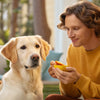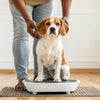Can You Feed a Dog Right After Exercise? Understanding the Best Practices for Your Furry Friend's Nutrition
- Houndsy
Table of Contents
- Introduction
- The Science Behind Dog Digestion and Exercise
- Risks of Feeding Immediately After Exercise
- How Long Should You Wait Before Feeding?
- Best Practices for Feeding Active Dogs
- Feeding Techniques for Various Dog Types
- Conclusion
Introduction
As loving pet owners, we often find ourselves questioning the best ways to care for our furry companions. One of the most common concerns is the timing of meals in relation to exercise. Did you know that feeding your dog too soon after a vigorous play session or a long walk can lead to serious health issues? Recent studies suggest that waiting for a certain period after exercise before feeding our dogs can significantly improve their digestion and overall health.
In this blog post, we will explore the critical aspects of feeding dogs after exercise, including the potential risks of immediate feeding, the ideal waiting times, and how to create a feeding schedule that promotes optimal health for your canine companion. By the end, you'll have a better understanding of your dog's nutritional needs and how to enhance their daily feeding routine.
Let’s dive into the nuances of canine nutrition and exercise, and discover how to keep our pets healthy and happy!
The Science Behind Dog Digestion and Exercise
When we talk about canine nutrition, it’s essential to understand how a dog’s digestive system functions. Dogs, like humans, require a well-timed balance of food and exercise for optimal health. Their bodies are designed to digest food most efficiently when they are calm. During exercise, blood flow is redirected from the digestive system to the muscles, heart, and lungs to support physical activity.
This physiological response can slow down the digestive process, making it crucial to consider the timing of meals. If a dog eats immediately after exercise, the combination of a full stomach and physical activity can lead to digestive upset, including bloating and nausea.
Key Takeaway: The timing of feeding in relation to exercise is critical for maintaining your dog’s digestive health.
Risks of Feeding Immediately After Exercise
Feeding your dog right after exercise can have several adverse effects, including:
- Bloat (Gastric Dilatation-Volvulus): This life-threatening condition is characterized by the stomach filling with gas, fluid, or food, causing it to expand and twist. Large and deep-chested breeds are particularly at risk, but all dogs can be affected. Symptoms include a swollen abdomen, excessive drooling, restlessness, and attempts to vomit.
- Digestive Upset: Dogs that eat immediately after vigorous exercise may experience nausea, vomiting, or diarrhea. This discomfort can detract from their overall enjoyment of mealtime and exercise.
- Lethargy: If a dog is fed right after exercise, they may become sluggish and uncomfortable as their body tries to digest food while still recovering from physical activity.
Key Takeaway: Feeding your dog immediately after exercise can lead to serious health risks, including bloat and digestive upset.
How Long Should You Wait Before Feeding?
Most experts agree that the ideal waiting time before feeding your dog after exercise is between 30 minutes to an hour. This allows their body to cool down and their digestive system to stabilize. The precise waiting time can vary based on several factors, including:
- Type of Exercise: More intense activities, such as running or playing fetch, may require a longer wait time compared to lighter activities like leisurely walks.
- Dog’s Age and Breed: Puppies and senior dogs may have different digestive needs, and larger breeds are at a higher risk for bloat. Adjusting the waiting time based on these factors is essential.
- Individual Health Conditions: If your dog has a history of digestive issues or is prone to bloat, you should be particularly cautious and may want to extend the waiting period.
Key Takeaway: A waiting period of 30 minutes to an hour is generally recommended before feeding your dog after exercise, but this can vary based on activity level, breed, and individual health.
Best Practices for Feeding Active Dogs
Feeding an active dog requires a strategic approach to ensure they receive the right nutrition without risking their health. Here are some best practices to consider:
1. Establish a Consistent Feeding Schedule
Creating a routine helps your dog anticipate mealtime, making it easier for both of you. Aim for two meals a day at approximately the same time, allowing a clear separation between eating and exercise.
2. Portion Control Based on Activity Level
Adjust portion sizes based on your dog’s activity level. If they have been particularly active, consider increasing their meal size slightly to replenish lost energy. Conversely, reduce portions on less active days.
3. Hydration is Key
Ensure your dog has access to fresh water before and after exercise. Hydration is vital for digestion and overall health, especially after physical activity.
4. Quality Nutrition Matters
Invest in high-quality dog food that provides balanced nutrition. Look for options that include lean proteins, whole grains, and fruits or vegetables. Foods rich in omega fatty acids are also beneficial for maintaining healthy skin and coat.
5. Monitor Your Dog’s Behavior
Pay attention to how your dog reacts to their feeding and exercise routine. If they show signs of discomfort after eating or exercising together, you may need to adjust the timing or portion sizes.
Key Takeaway: Establishing a consistent feeding schedule, controlling portions based on activity, ensuring hydration, and monitoring behavior are crucial for keeping your dog healthy and happy.
Feeding Techniques for Various Dog Types
Different breeds and ages of dogs may require tailored feeding strategies. Here are some guidelines based on various categories:
Puppies
- Frequent, Smaller Meals: Young dogs require more frequent meals (3-4 times a day) to support their rapid growth. They may be more tolerant of shorter waiting times after exercise compared to adult dogs.
Adult Dogs
- Consistent Two Meals: Most adult dogs do well on two meals per day. Ensure that there’s a clear separation between mealtime and exercise, waiting at least an hour after eating before physical activity.
Senior Dogs
- Monitor Digestive Health: Older dogs may have slower metabolisms and digestive concerns. Be mindful of their portion sizes and adjust them based on their activity levels and overall health conditions.
Large or Deep-Chested Breeds
- Extra Caution: Breeds like Great Danes or Dobermans are prone to bloat. Always wait at least an hour after exercise before feeding and consider feeding smaller, more frequent meals throughout the day.
Key Takeaway: Tailoring feeding practices to the specific needs of your dog can help address their unique health considerations and promote better digestion.
Conclusion
Understanding the relationship between exercise and feeding is essential for maintaining your dog's health and well-being. By allowing adequate time between exercise and feeding, we can minimize the risk of digestive issues and support our dogs’ overall nutrition.
As we strive to create a more enjoyable feeding experience, consider investing in innovative products like the Houndsy Kibble Dispenser. With its sleek design and ergonomic features, it ensures that meal times are both convenient and stylish, enhancing the daily feeding ritual while maintaining the health of your beloved pet.
FAQs
Q: Can I walk my dog 30 minutes after eating?
A: While some dogs may tolerate this, it is generally safer to wait at least an hour after eating before engaging in exercise to avoid digestive issues.
Q: What are the signs of bloat?
A: Look for symptoms such as a swollen abdomen, excessive drooling, restlessness, and attempts to vomit. If you notice these signs, seek veterinary assistance immediately.
Q: How can I adjust portion sizes for my dog?
A: Increase or decrease portion sizes based on your dog's activity level each day. Keep track of their weight and consult with your veterinarian if you have concerns.
Q: Is it better to feed my dog before or after exercise?
A: It’s generally better to feed your dog after exercise, but allow for a waiting period of at least 30 minutes to an hour to reduce the risk of digestive issues.
Q: What should I feed my dog after exercise?
A: Provide a balanced meal of high-quality dog food that includes lean proteins, whole grains, and fruits or vegetables to help replenish lost energy.
By following these guidelines, we can ensure that our dogs receive the best care possible, promoting their health and happiness for years to come!













